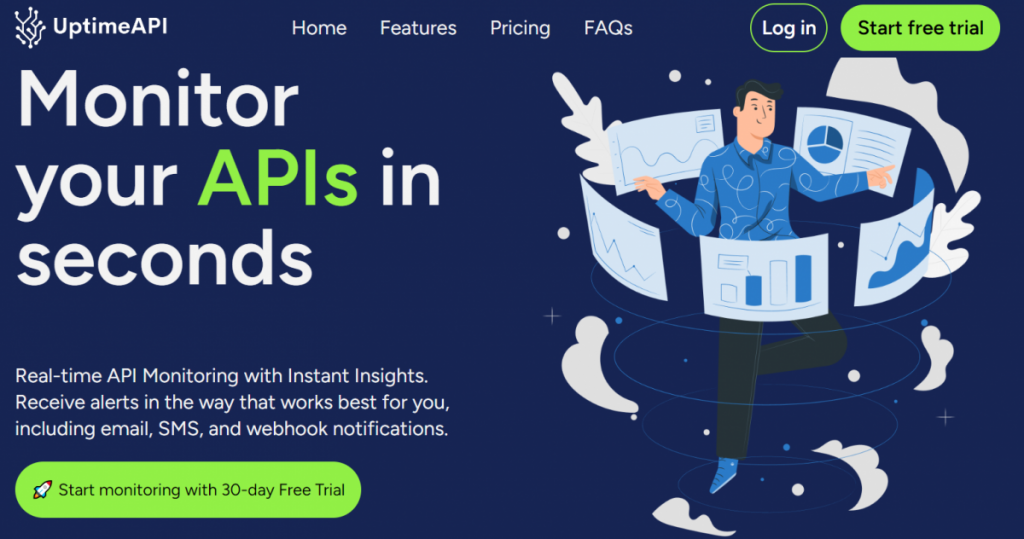In the realm of web development, Application Programming Interfaces (APIs) serve as the backbone for communication between different software systems. Ensuring the reliability and functionality of APIs is a critical aspect of the development process. This is where API testing comes into play. In this comprehensive introduction, we will delve into the fundamentals of API testing and explore how UptimeAPI, a powerful monitoring tool, aids developers in ensuring the robustness of their APIs.
Understanding API Testing

1. What is API Testing?
API testing involves evaluating the functionality, performance, and security of an API. It ensures that the API reliably performs the intended functions, handles errors gracefully, and meets performance expectations. APIs testing is crucial for identifying bugs, improving the overall quality of the software, and ensuring seamless integration with other components.
2. Why is API Testing Important?
- Early Bug Detection: APIs testing allows developers to catch bugs and issues early in the development process, reducing the cost of fixing problems later.
- Integration Validation: As APIs enable communication between different components, testing ensures that various parts of the software work cohesively.
- Performance Optimization: APIs testing helps in identifying performance bottlenecks, ensuring that the API meets response time and throughput requirements.
- Security Verification: Security vulnerabilities can be uncovered through API testing, enabling developers to fortify their systems against potential threats.
Types of API Testing

Read More: Company profile APIUsage Cases
1. Unit Testing
Unit testing involves testing individual functions or methods of an API in isolation. It ensures that each unit of code performs as expected.
2. Integration Testing
Integration testing focuses on verifying that different components of the API work together seamlessly. It ensures that data flows correctly between integrated modules.
3. Functional Testing
Functional testing evaluates the API’s functionality by testing its inputs and outputs. It ensures that the API performs its intended operations accurately.
4. Performance Testing
Performance testing assesses the API’s responsiveness, scalability, and speed under various conditions. It helps in identifying and addressing performance bottlenecks.
UptimeAPI: Enhancing APIs Testing with Real-Time Monitoring
UptimeAPI extends its functionality beyond conventional testing by providing real-time monitoring for API endpoints. This capability complements traditional testing methodologies, offering developers insights into the live performance and availability of their APIs.
API Responses with UptimeAPI
Understanding API responses is integral to effective testing and monitoring. UptimeAPI provides developers with clear and informative responses that indicate the status of monitored API endpoints.
1. Healthy Response
A healthy API response signifies that the monitored endpoint is operational. This response typically includes a success status code (e.g., 200 OK).
{
“status”: “success”,
“message”: “API endpoint is reachable.”,
“timestamp”: “2024-01-17T12:00:00Z”
}
2. Failed Response
A failed API response indicates that the monitored endpoint is experiencing issues or is unreachable. This is accompanied by a status code outside the 2xx range.
{
“status”: “failed”,
“message”: “API endpoint is not reachable.”,
“timestamp”: “2024-01-17T12:05:00Z”
}
3. Performance Metrics
UptimeAPI goes beyond binary responses by providing performance metrics, allowing developers to assess the responsiveness and speed of their APIs.
{
“status”: “success”,
“message”: “API endpoint is reachable.”,
“response_time”: 150, // Response time in milliseconds
“timestamp”: “2024-01-17T12:10:00Z”
}
Getting Started with UptimeAPI for APIs Testing
1. Sign Up for UptimeAPI Account
Begin by signing up for an account on the UptimeAPI website. Once registered, access the UptimeAPI dashboard.
2. Add API Endpoints
In the dashboard, add the API endpoints you want to monitor. Specify the endpoint URLs and any additional parameters required for monitoring.
3. Set Up Alerts
Customize alert preferences to receive notifications for downtime or performance issues. Define conditions that trigger alerts, such as response time thresholds or consecutive failures.
4. Integration with Testing Workflow
UptimeAPI seamlessly integrates with various testing frameworks. Incorporate UptimeAPI into your testing workflow by following the provided documentation for your preferred programming language or testing tool.
Best Practices for APIs Testing with UptimeAPI
1. Combine Testing and Monitoring
Integrate UptimeAPI monitoring into your testing processes to gain real-time insights into the live performance of your APIs during testing scenarios.
2. Set Realistic Performance Benchmarks
Leverage UptimeAPI’s performance metrics to set realistic benchmarks for your API’s response time and throughput, ensuring optimal performance.
3. Continuous Monitoring
Use UptimeAPI’s continuous monitoring to identify and address issues as soon as they arise, enabling proactive responses to potential problems.
Conclusion: Elevate Your API Testing with UptimeAPI
APIs testing is an integral part of the development lifecycle, ensuring the reliability, performance, and security of APIs. UptimeAPI enhances this process by providing real-time monitoring, enabling developers to go beyond traditional testing methodologies. By incorporating UptimeAPI into your API testing workflow, you gain valuable insights into live performance and receive timely alerts for potential issues. Elevate your API testing with UptimeAPI and ensure the seamless operation of your APIs in real-world scenarios.
